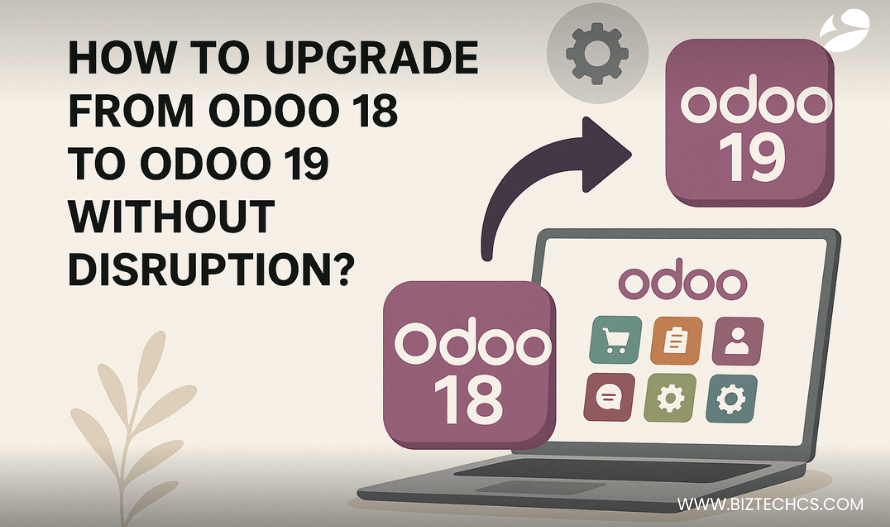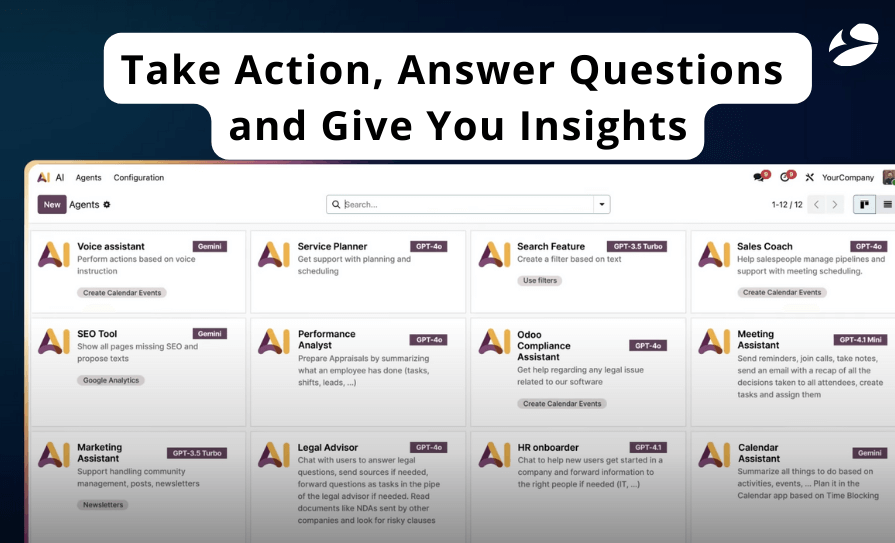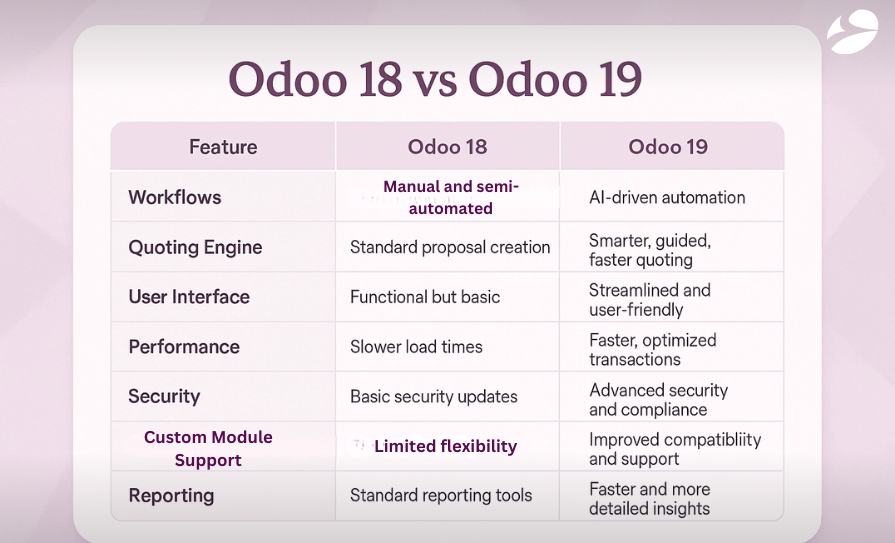
https://www.biztechcs.com/blog/odoo-18-to-19-migration-guide/
Today, having Odoo 18 is similar to having a good ol’ flip phone, while others are the proud owners of the latest iPhone 17. It still works, but a comparison in relation to speed, security, and features would definitely put things against Odoo 18.
Odoo 19, with its AI-powered workflow, intelligent quoting tools, and an even better user experience, makes daily operations less of a chore and more like second nature. Staying on Odoo 18 may not only open up security gaps but also cause lost opportunities for efficiencies that competitors may already be enjoying.
There is a saying, “Don’t wait for the well to dry before you start valuing water.” Timely upgrades indeed save you bigger headaches later, and this is where migrating Odoo 18 to 19 migration services step in to empower businesses with confidence and clarity.
In the hands of seasoned Odoo migration experts, the transition then becomes less of a disruption and more of a strategy. With the right odoo migration services, the process of moving from Odoo 18 to 19 becomes more than just an upgrade it becomes a strategic step toward sustained growth. This blog will spotlight why the shift matters, who benefits most, and how to migrate Odoo 18 to 19 in the smoothest possible way.
What Is Odoo 19 and How Does it Differ from Odoo 18?
Before diving into the details, let’s look at the key features that set Odoo 19 apart from Odoo 18.
Key features of Odoo 19
AI-Driven Workflows
Odoo 19 offers AI-powered workflows, which uplift processes to make them more intelligent and reduce repetitive tasks. Fortunately, automatic approvals, data sending, and notifications run with little to no manual effort. This leaves the team with less busywork, allowing them to focus on more significant decisions.
The improvement introduces intelligent automation that feels natural for the end-user to embrace. The migration of Odoo 18 to 19, assisted by Odoo migration experts, will provide great support in implementing these features.

Smarter Quoting Engine
The quoting engine of Odoo 19 has been reimagined to reduce delays and make errors less frequent. As a result, sales teams can create proposals faster and more accurately, reducing a lot of back-and-forth communication.
The interface is cleaner, and the suggestions guide users more effectively through the quoting process. All this leads to time and money savings on one hand and an improved client experience on the other. This is a step worth considering during Odoo 18 to 19 migration services.
Enhanced User Experience
User comfort is the focal point of Odoo 19 with its new and improved UI. Experience smooth transitions between screens, with a greater emphasis on ease when conducting important functions. Employees adapt quickly, thus shortening the required transition time.
The subsequent pleasant experience helps departments achieve higher adoption rates. Get the entire organization to feel this benefit through a timely Odoo upgrade service.
Productivity Updates
Odoo 19 has improved its performance with faster page loading times and a smoother flow of transactions. Companies once limited by delays will notice the difference immediately. In simple terms, it now takes less time to raise invoices or review reports, thereby increasing output with the actual capacity employees have. So, to migrate Odoo 18 to 19 is all about embracing the fast-paced world of daily operations.
Is your team spending too much time waiting on slow systems? Odoo 19 delivers the speed modern businesses demand.
Comparison: Odoo 18 vs Odoo 19

How to Migrate Odoo 18 to Odoo 19 Successfully?
To make the shift smooth and secure, the migrate Odoo 18 to 19 process can be broken down into clear steps:
Step 1: Backup and Prepare the Environment
The foremost assurance for a successful migrate Odoo 18 to 19 is a reliable backup. Every record—one containing customer data and another perhaps an invoice—must be safeguarded before commencing the journey.
Setting up the staging environment allows the company to test for any changes that may affect daily operations. Such an environment is much like a rehearsal for the big production, where every detail has to be perfect. This ensures that any disturbances that might hinder revenue or customer trust can be averted.
As the old saying goes, “An ounce of prevention is worth a pound of cure.” Once this sturdy foundation is laid, the subsequent stages will proceed confidently in the migration.
Step 2: Review Custom Modules
Custom modules give every Odoo setup its special flavor, yet they must be carefully examined prior to migration. Some of them may be perfectly compatible with Odoo 19, while others will need adjustments.
A detailed audit brings to light what can be moved forward and what must be modified. Businesses risk interruptions caused by errors if they neglect this important step. By addressing it early, one saves time from scrambling at the end.
Think of it as an inspection of your baggage before flying; it is better to find out now what fits and what doesn’t. Thorough preparation ensures a smooth transition.
Step 3: Migrate the Core Database
After the base has been prepared, the core database migration takes center stage. This step ensures that all important records are safely moved from Odoo 18 to Odoo 19. Products, orders, and finance records must be transferred without corruption.
Accuracy is critical because even small misfits may cause larger issues down the line. Migration testing at regular intervals helps keep errors at bay. This stage becomes safer and reliable with the support of Odoo 18 to 19 migration services. Ensuring a clean migration sets the tone for the entire upgrade.
Step 4: Upgrade or Rewrite Custom Modules
After the database goes live on Odoo 19, the focus turns to custom modules. Some may work with minimal tweaks, while others must be rewritten completely. This step ensures that business logic continues to sustain unique processes.
Ignoring module compatibility might lead to downtime or broken operations. Upgrading modules also allows businesses to take advantage of new features Odoo 19 has to offer. The right Odoo upgrade service makes this phase less complicated and more dependable. By balancing the old with the new, businesses get the best of both worlds.
Feeling concerned about data accuracy or module downtime during migration? With the right Odoo Migration Services and experienced Odoo migration experts, these risks vanish quickly.
Step 5: Test and Validate
Testing serves as the final safety mechanism to guard against errors that could affect users. It is essential that testing validates every function, from creating a sales order to issuing reports. In this process, data is tested for correctness, and workflows are checked against expectations.
Errors found during this stage are easier to fix with minimal consequences. This validation also gives the team confidence that the system is ready for daily use. Remember the old saying, “Measure twice, cut once.” Careful testing now prevents much bigger headaches later.
Step 6: Go Live and Monitor
The migration to production on Odoo 19 is now underway. At this point, close supervision is essential so that minor glitches can be caught and resolved quickly. Teams should be supported with the proper instructions to embrace the new features confidently.
The initial few days under observation will provide stability. Downtime can be avoided with proactive mechanisms, keeping productivity intact. With trusted partners who migrate Odoo 18 to 19, the go-live phase feels like a milestone rather than a hurdle. This marks the close of the migration journey with success and the beginning of smooth operational efficiency.
Who Benefits the Most from Odoo 18 to 19 Migration Services?
Small and medium businesses benefit first, especially those still treating Excel sheets like a holy Scripture. Odoo 19 eliminates the late-night drama of copy-paste errors that drive finance teams to the brink of frustration.
Enterprises running their workflows on complicated systems finally get a system that does not feel like a never-ending puzzle designed by someone who hated them. The retail, manufacturing, and service industries can stop wrestling with obsolete tools that break faster than a cheap umbrella in a storm. Sales teams are no longer made to chase quotes like hunters chasing shadows.
Finance teams get to stop playing the role of Sherlock Holmes every month, trying to find out where the missing figures have run off to. Operations teams, typically those most affected by inefficiency, begin to work with some efficiency and no longer feel stuck in a hamster wheel.
With Odoo 18-to-19 migration services backed by seasoned Odoo migration experts, businesses can finally upgrade from their outdated systems to something that at least moves without rattling bolts.
When Is the Right Time to Migrate Odoo 18 to 19?
The right time to migrate Odoo 18 to 19 is not after your system has crashed and everyone at work spends every day as a survival game. It’s when demand increases, performance lags, and plain-old rusty modules start slapping you in the face. Waiting longer is worse than accepting the smoke until the entire house goes up in flames.
Budget planning should never feel like robbing Peter to pay Paul; hence, keeping a budget for an Odoo upgrade service shouldn’t be a last-minute, panic-driven event.
Common sense suggests scheduling the move during the off-peak season or aligning it with a weekend, unless you want to receive angry phone calls from an increasingly irate staff regarding stuck invoices, while customers are upset.
Businesses that do things right and engage Odoo 18 to 19 migration services avoid last-minute firefighting. With the proper guidance from Odoo migration professionals, what once was a big, high-risk job becomes less risky, finally swapping the rusty old bicycle for a car that actually starts in the morning. The right timing to migrate from Odoo 18 to 19 is not just smart but ensures a smooth business operation, free from errors.
Conclusion
Migrating from Odoo 18 to Odoo 19 is not just another tech upgrade, but the difference between riding a squeaky old scooter and arriving in a car that stalls at every traffic light! The migration process ensures data safety while refining workflows so the system does not collapse when teams need it the most.
Odoo 19 offers AI-powered workflows, quicker quotations, and much better security systems to almost get between you and your daily operations. Rejecting this upgrade is like choosing not to wear a parachute aboard a plane because the seatbelt feels good enough.
Each stage allows for a smooth transition with backups, module rewrites, and continuous changes, thereby helping keep the business running without rescue operations.
Testing and validation cover loopholes to prevent unforeseen surprises from creeping in, like those uninvited relatives at family dinners. With its launch, Odoo 19 paves the way for enduring growth, which is precisely where the proper training makes all the difference.
BiztechCS brings the combined expertise of seasoned Odoo migration experts who treat every migration with precision rather than mere guesswork. The team ensures minimal disruption and circus-level drama while migrating businesses from Odoo 18 to 19.
With years of Odoo 18 to 19 migration service experience behind them, BiztechCS ensures an upgrade so fitting that it feels more like an upgrade and less like open-heart surgery. With us, foregoing rookie mistakes guarantees a clean, efficient, and surprisingly painless migration.
Ready to upgrade without disruptions and enjoy a future-ready Odoo system? Let our experts guide your next step.
5 min read






